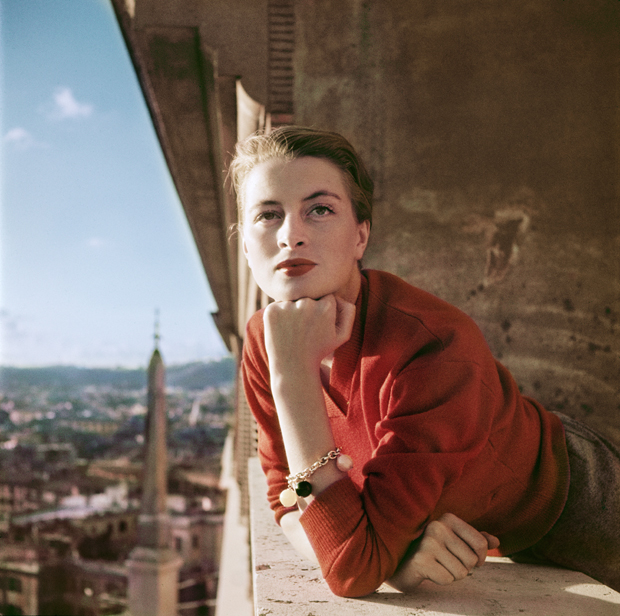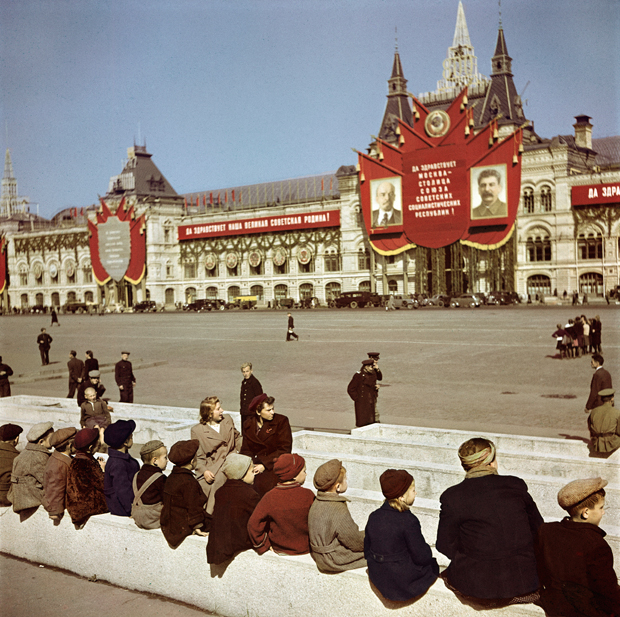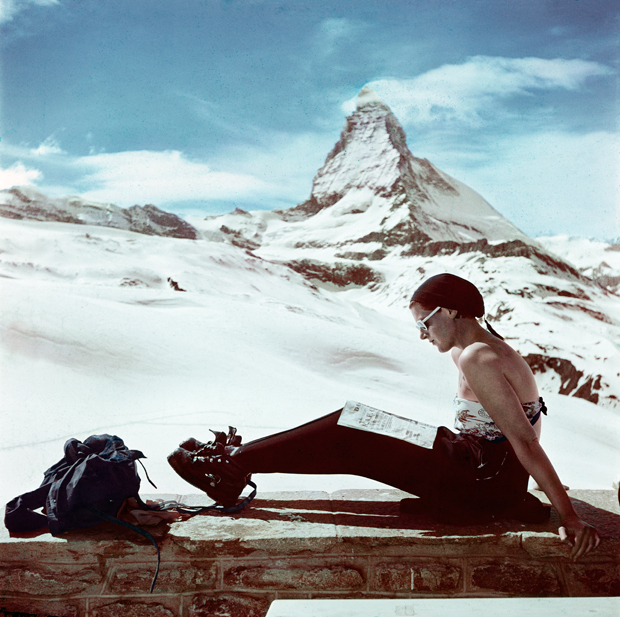Robert Capa in Color: the Photographer Inside Life
Roberto Saviano, author of the bestselling title Gomorrah, comments on the color work of Robert Capa in Capa in Color, an exhibition on view at the International Center of Photography January 31–May 4, 2014. This review first appeared in La Repubblica on April 13, 2014.

Robert Capa, [Capucine, French model and actress, on a balcony, Rome], August 1951. © Robert Capa/International Center of Photography/Magnum Photos.
NEW YORK – As a young boy, in contests to see who could hold their breath the longest, he got as far as three minutes. It’s a mental discipline, and if you succeed in holding your breath, in not giving in to the tyranny of the diaphragm, then you also succeed in controlling your emotions.
I arrive at the International Center of Photography in New York and breathe in through my nose, inhaling all the air I can, filling my lungs. Faced with images that, piece by piece, have constructed my worldview, I really don’t know if my vital functions will remain unaltered. Encountering Robert Capa’s photographs is like standing before work by Raphael or Caravaggio. All the images in your mind of the Second World War, of the American troops in Italy, of the war in Spain, of the Jews who survived the concentration camps, of the bombed out cities, in other words all those images hidden in some far-off corner of your memory, live within you because Robert Capa lived. A photojournalist who almost always had his camera handy and who never released the shutter without receiving an advance for an assignment.
At this point his most famous shots belong to our collective memory: the anarchist militiaman shot to death in the Spanish Civil War, perhaps his most cited photo; the mothers in mourning around the coffins of children from the Liceo Sannazaro who were killed fighting the Germans during the Four Days of Naples; blurry images of the Normandy landing, which inspired Spielberg for the opening sequences of Saving Private Ryan. These are, by definition, black and white photography, and this is why “Capa in Color,” the ICP exhibition that commemorates the one-hundredth anniversary of the photographer’s birth, delivers a sort of visual shock.
First of all there is the incredible image of Capucine, the stunning and unfortunate woman who committed suicide at age sixty-two. Incredible because you get so close to her, you feel the breath from her nostrils. Her chin resting on her hand, the light of Piazza di Spagna, her red shirt: this shot seems to already contain everything about her fate, and it offers proof that Capa’s art, with his eye, with his unique gaze, lays the foundation for a literary genre.

Robert Capa, [Young visitors waiting to see Lenin’s Tomb at Red Square, Moscow], 1947. © Robert Capa/International Center of Photography/Magnum Photos.
My education, everything I have written, everything written by the authors who have influenced me, derives directly from him. Literary, iconographic and cinematographic neorealism all draw on Robert Capa. His biographers describe this photographer, barely five feet three inches tall, as an indomitable lover, someone who would punctually disappear when the object of his love indicated that she wanted to tie him down, to share a life with him. He had also loved Ingrid Bergman, and indeed it was he who had introduced her to Rossellini, the Italian Neorealist filmmaker. The latter was inspired by Capa’s esthetic rigor, whereby he not only sought to unearth drama, but also its dangerous communicative beauty, in order to enable that drama to transform the observer. This is Capa’s most profound lesson for cinema. His work not only allowed us to construct an extremely personal and sumptuous mosaic. No, Capa did much more: he created literature and communication, in the most modern sense of the terms.
His way of shooting is neither denunciation nor indignation, nor an artistic choice; it is all three together. And this is true only because his glance – immersed in life, drenched in and sullied by life – implicates. Someone who is not afraid of life, not afraid of people. “If your photographs aren’t good enough, you’re not close enough,” according to his most well-known maxim. Getting inside things. This is precisely what Capa’s color photographs reveal: that he is not at war, but inside war, among the soldiers, so close he puts his own life at risk. And this is true for all his photography. Even when he shoots Truman Capote in Ravello, or Martha Gellhorn walking amid the ruins of the temple of Ceres in Paestum. He gets inside everything he photographs. Inside all the people he photographs.
His shots cost him eternal, deep hatred. He was never forgiven for the photograph of the anarchist militiaman, the authenticity of which has been questioned by an entire body of literature. Likewise he has never been forgiven for his color photographs of the Stalinist USSR, published with texts by John Steinbeck, detested by the communists because they are anti-communist and by the anti-communists because they are pro-communist. Whatever photos he shot, he knew that he would stir up instinctive reactions. He liked capturing images of the world and transforming the way people looked at the world.

Robert Capa, [Skier sunbathing in front of the Matterhorn, Zermatt, Switzerland], 1950. © Robert Capa/International Center of Photography/ Magnum Photos.
But the photographs I am seeing not only change my way of looking at the world; it is as if they were giving birth to an urgency, as if they were setting off an alarm: go back to looking at the world and don’t limit yourself to merely copying it, to extracting from everyday life some image or another in order to put it back in circulation, to bombard people with useless stills that saturate the glance but go no further. In fact, it isn’t enough to see these shots by Capa, it isn’t sufficient to look at them and then move on; one needs to stop and read them. In Holiday magazine Capa wrote: “I went back to photograph Budapest because I happened to have been born there; I was able to photograph Moscow, which is impossible for most people to do; I photographed Paris because I lived there before the war; London because I lived there during the war; and Rome because I was unhappy I had never seen it and instead would have liked to live there.” There are photographs of American families in Switzerland, in glossy tourist magazines, or those that were disseminated at travel agencies. There is Magnani during the shooting of Visconti’s Bellissima. Capa photographs everyone in every sort of situation, famous people and unknowns, without snobbery, because he wasn’t interested in playing a role — for him, the priority was to get inside life. He knew that observation entailed getting involved, and this didn’t scare him off.
He had learned from Gerda Taro, his companion. Gerda died at twenty-seven, struck by a “friendly” tank of the Republican Popular Front. She was looking into her camera while standing on the running board of a military vehicle. Hit, she fell and ended up beneath the wheels. In 1954, in Indochina, Robert Capa was also looking into his camera. He had decided to wait for a French military column that was advancing. He went up an embankment. Retreating, he stepped on a landmine. Gerda and Robert never distanced themselves from their subjects. And this getting inside, inside the eyes of the people in front of you, their muscle structure, the landscapes, the creases of a model’s glance, the pride and dissatisfaction of a bourgeois entrepreneur: all this is research. Capa photographs with an awareness that it is precisely when you begin to believe that life is shutting you out, that there is no point in seeking the truth, that you have lost the only chance to be truly alive, to be able to make an impression on this world. As soon as you decide to take one of the possible shortcuts, in order to mimic life, you have already lost. Robert Capa’s secret does not lie in the end product, but in the search, in the voyage, which cannot exist without completely implicating himself. The only salvation lies in getting inside what you want to understand. Getting inside life.
(Translated from the Italian by Marguerite Shore.)
—
Roberto Saviano is an Italian journalist and writer. He is the author of numerous publications, including Gomorrah (Mondadori, 2006), La bellezza e l’inferno (Beauty and the Inferno, Mondadori, 2009), and most recently Zero Zero Zero (Feltrinelli Editore, 2013). He is a regular contributor to La Repubblica.
Selected photographs from Capa in Color will be on view this summer on Governors Island, New York. Visit At Governors Island: Capa in Color from July 3 to September 28, 2014.























